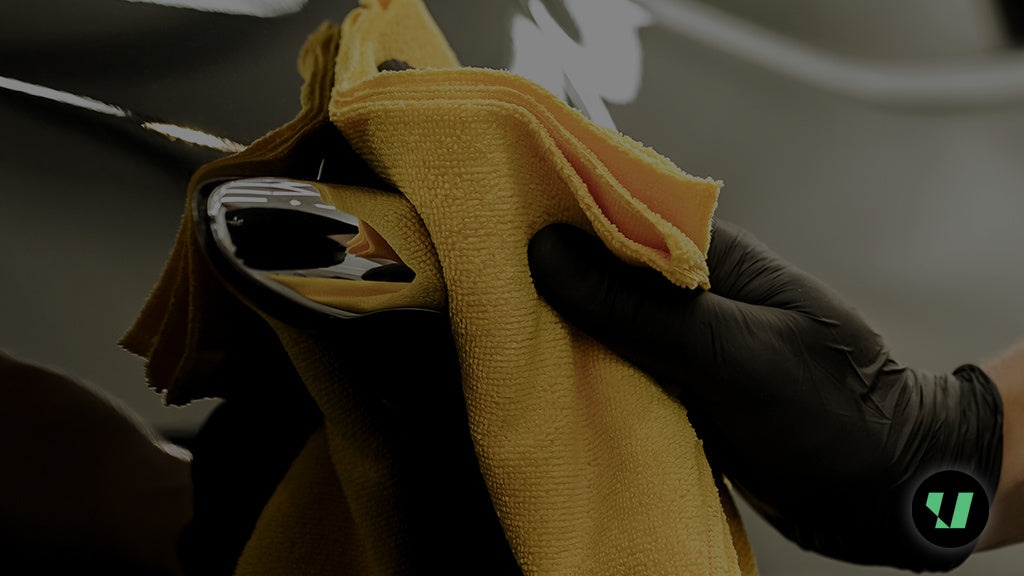
Microfibre – what is it? Why it’s essential in car detailing
Share

Microfibre has become a staple in the world of car detailing, interior cleaning, and sportswear. But what exactly is it? Why is this material so popular? And how does it compare to other options like microfleece? In this article, we take a closer look at microfibre and show you why it’s worth knowing its properties – especially if you care about effective, safe, and comfortable work.
Microfibre – what kind of material is it?
Microfibre (also: microfibre or micro denier) is a material made from ultra-fine synthetic fibres: usually a blend of polyester and polyamide (nylon). The thickness of a single microfibre strand is less than 1 denier – thinner than a human hair. This microscopic scale is the key to the unique properties of the material.
It’s worth emphasizing that it’s the thinness and density of the fibres that give microfibre cloths such a large contact area with the cleaned surface. This directly improves dirt removal efficiency and helps minimize the risk of scratching paint or other delicate materials.
But microfibre isn’t just “something thin.” It’s a structure that makes a real difference in practice. The fibres are often split into microgrooves that increase absorbency, dirt pickup, and softness on contact with surfaces.

Features of microfibre – why is it so effective?
1. Absorbency
Microfibre can absorb up to seven times its weight in water. This makes it ideal for drying, car cleaning, and polishing – without streaks or water spots.
2. Dirt attraction
Thanks to its electrostatic charge and the grooves in the fibre structure, microfibre “attracts” dust, dirt, and grease instead of just smearing them.
3. Gentle on surfaces
With no sharp edges and a soft structure, it won’t scratch surfaces – a huge plus in car detailing. A well-chosen –for car paint allows safe work even on the most delicate finishes.
4. Durability
High-quality microfibre can be washed dozens of times without losing effectiveness. The key? Don’t use fabric softener and don’t wash above 60°C. If you’re unsure how to wash microfibre, remember: mild detergent, no softeners, and air drying are the basics.
5. Fast drying and bacteria resistance
Microfibre dries faster than cotton, which reduces bacterial growth – ideal for maintaining hygiene.

Microfibres vs. microfleece – what’s the difference?
Are microfibre and microfleece the same thing? Although the names sound similar, they’re not synonyms.
Microfleece is a type of microfibre, typically with even finer fibres and a more silky texture. Commonly used in cosmetics – e.g., makeup removal cloths because it’s extremely gentle.
Microfibre is a broader term. It comes in various pile lengths, structures, and weights. Depending on how it’s constructed, it can be used for polishing paint, drying glass, or cleaning car interiors.
Advantages and disadvantages of microfibre

Types of microfibre
Microfibre is not a one-size-fits-all cloth. There are different types that vary in pile length, GSM, cut type, and application:
-
Short pile: for degreasing, cleaning windows, hard surfaces. Ideal microfibre for windows and precision work
-
Medium pile: universal – for polishing, drying, finishing
-
Long pile: great for initial drying or removing quick detailers
-
Edgeless microfibre cloths: reduce the risk of scratching paint
-
High polyamide content: better absorbency and softness – especially valued in car detailing
Microfibres in detailing
In the ULTRACOAT portfolio, you’ll find microfibre cloths designed for specific tasks. Each has different properties, GSM, and fibre type. If you’re wondering which microfibre to choose for your car – here’s a quick guide:
Yellow Bahama
A soft, fluffy microfibre with long pile that helps remove residues of quick detailers, waxes, and coatings without the risk of scratching delicate paintwork. Perfect for situations where gentleness and precision are crucial during the finishing stage. 500 GSM, size 40×40 cm.

Silky Finish – Ultra-Soft Edgeless
400 GSM, medium pile, laser-cut edges. Ideal for removing polish and sealant residues. Helps dry surfaces without leaving streaks or risking paint damage.

Purple Blaze – Closed-Pile Edgeless
Short, closed-pile microfibre designed for cleaning glass and degreasing both glass surfaces and car interiors. The edgeless construction minimizes the risk of scratches, while the high polyamide content improves dirt pickup. 320 GSM.

Gentle Buff – Short Pile Edgeless
Universal microfibre for paintwork, interiors, and ceramic coating removal. Short pile, laser-cut edges, and uncompromising quality of Korean microfibre. 320 GSM.

Summary – microfibre is a must-have
Microfibre cloths prove their worth in everyday detailing thanks to their key properties: they’re absorbent, gentle, durable, and highly versatile. It’s worth investing in high-quality products – especially if you care about your car’s interior or paintwork. That’s why you should always choose microfibre designed specifically for detailing – it helps prevent scratches and makes cleaning significantly easier.
Microfibre for cars is one of the essential tools in every car enthusiast’s kit – that’s why it’s important to choose it wisely.
